2015 MERCEDES-BENZ SLS AMG GT COUPE tow
[x] Cancel search: towPage 49 of 290
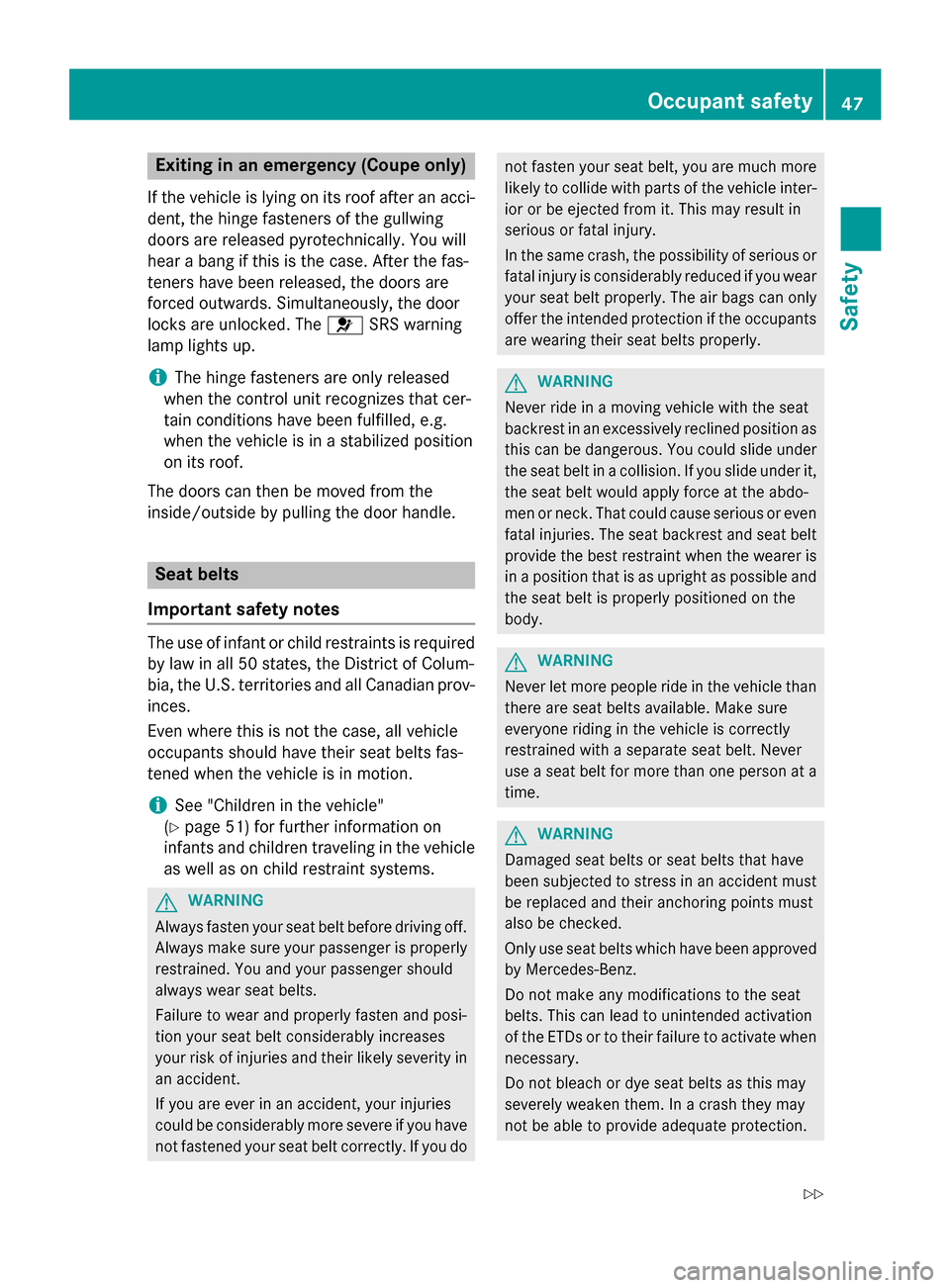
Exiting in an emergency (Coup
eonly)
If th evehicle is lying on its roo fafter an acci-
dent, th ehinge fasteners of th egullwing
door sare released pyrotechnically. You will
hear abang if this is th ecase. Afte rthe fas-
teners have been released, th edoor sare
forced outwards .Simultaneously, th edoor
locks are unlocked. The 0075SRS warning
lamp light sup.
i The hinge fasteners are only released
when th econtrol unit recognize sthatc er-
tain condition shave been fulfilled, e.g.
when th evehicle is in astabilized position
on its roof.
The door scan then be moved from the
inside/outside by pullin gthe door handle. Seat belts
Important safety notes The use of infant or child restraint
sisrequired
by law in all 50 states, th eDistrict of Colum-
bia, th eU.S.terri tories and all Canadian prov-
inces.
Even wher ethisisn otthec ase, all vehicle
occupant sshoul dhave their seat belt sfas-
tene dwhen th evehicle is in motion.
i See "Children in th
evehicle"
(Y page 51) for further informatio non
infant sand childre ntravelin gint hevehicle
as well as on child restraint systems. G
WARNING
Always fasten your seat belt before driving off. Always mak esure your passenger is properly
restrained. You and your passenger should
always wear seat belts.
Failur etow ear and properl yfasten and posi-
tio ny our seat belt considerably increases
your risk of injuries and their likely severit yin
an accident.
If you are ever in an accident, your injuries
coul dbec onsiderably mor esevere if you have
no tfastene dyour seat belt correctly. If you do no
tfasten your seat belt ,you are muc hmore
likely to collide with part softhevehicle inter-
ior or be ejected from it. This may result in
serious or fatal injury.
In th esame crash, th epossibilit yofserious or
fatal injury is considerably reduced if you wear
your seat belt properly. The air bags can only offer th eintended protection if th eoccupants
are wearin gtheir seat belt sproperly. G
WARNING
Never ride in amoving vehicle with th eseat
backres tinanexcessively recline dposition as
this can be dangerous. You coul dslide under
th es eat belt in acollision .Ifyou slide unde rit,
th es eat belt would apply force at th eabdo-
men or neck. That coul dcaus eserious or even
fatal injuries .The seat backres tand seat belt
provide th ebest restraint when th eweare ris
in ap osition that is as upright as possible and
th es eat belt is properl ypositioned on the
body. G
WARNING
Never let mor epeopl eride in th evehicle than
there are seat belt savailable. Mak esure
everyone ridin ginthevehicle is correctly
restraine dwithaseparate seat belt .Never
use aseat belt for mor ethano neperson at a
time. G
WARNING
Damaged seat belt sorseat belt sthath ave
been subjected to stres sinanaccidentmust
be replaced and their anchoring points must
also be checked.
Only use seat belt swhichhave been approved
by Mercedes-Benz.
Do no tmakea ny modifications to th eseat
belts. This can lead to unintende dactivation
of th eETDsortot heir failur etoactivat ewhen
necessary.
Do no tbleac hord ye seat belt sasthism ay
severel yweaken them. In acrash they may
no tbea ble to provide adequat eprotection. Occupant safety
47Safety
Z
Page 51 of 290
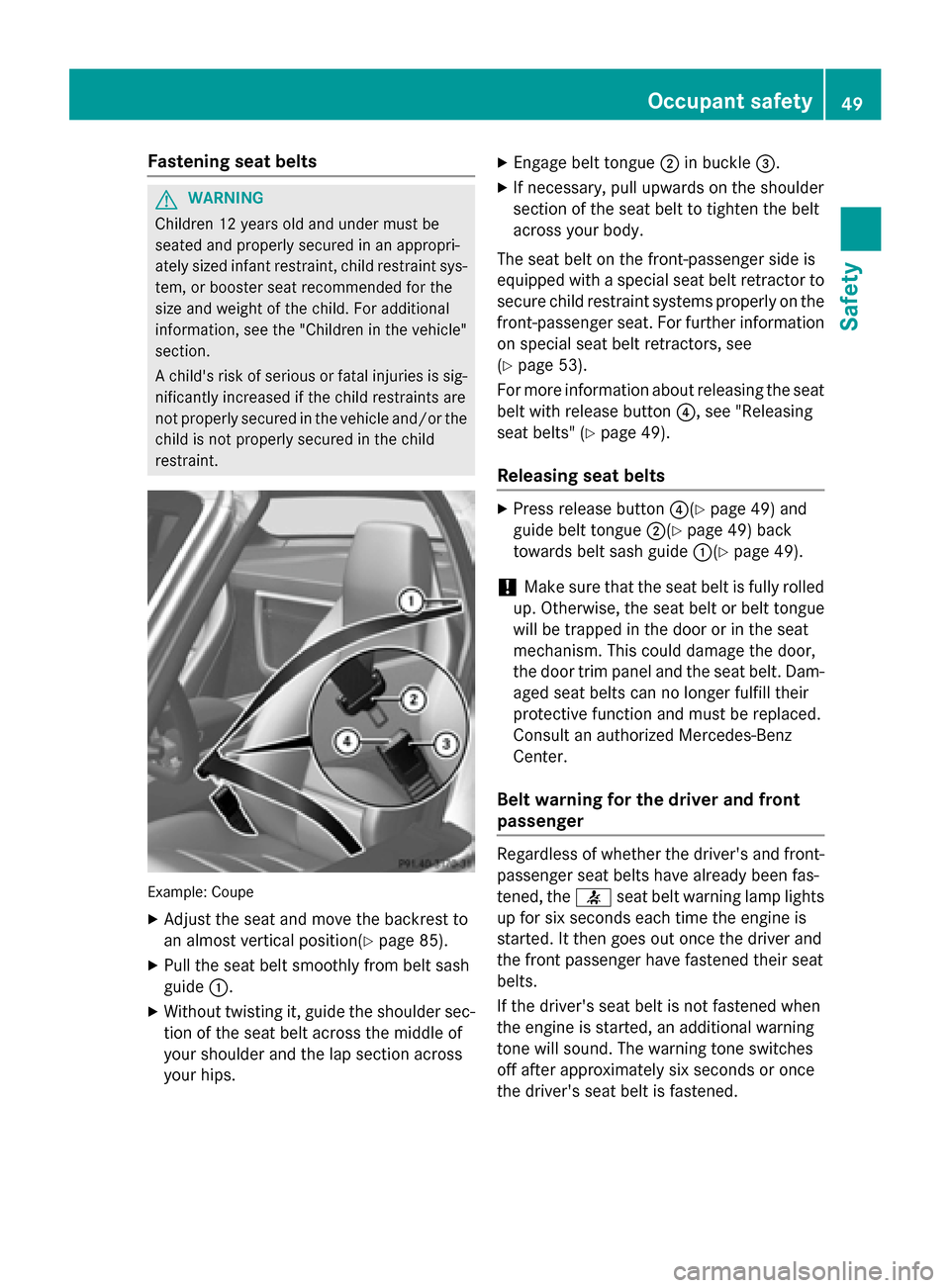
Fastening seat belts
G
WARNING
Children 12 years old and under must be
seated and properly secured in an appropri-
ately sized infant restraint, child restrain tsys-
tem, or booste rseat recommended for the
siz ea nd weigh tofthechild. Fo radditional
information ,see th e"Children in th evehicle"
section.
Ac hild's ris kofserious or fatal injurie sissig-
nificantl yincreased if th echild restraints are
no tproperly secured in th evehicl eand/o rthe
child is no tproperly secured in th echild
restraint. Example: Coupe
X Adjus tthe seat and mov ethe backrest to
an almost vertical position(Y page 85).
X Pull th eseat belt smoothly from belt sash
guide 0043.
X Without twisting it ,guide th eshoulder sec-
tion of th eseat belt across th emiddle of
your shoulder and th elap section across
your hips. X
Engage belt tongue 0044in buckle 0087.
X If necessary, pull upward sontheshoulder
section of th eseat belt to tighten th ebelt
across your body.
The seat belt on th efront-pa ssenger side is
equipped wit haspecial seat belt retracto rto
secure child restraint systems properly on the
front-passenger seat .For further information
on special seat belt retractors, see
(Y page 53).
Fo rm orei nformation about releasin gthe seat
belt wit hrelease button 0085,see "Releasing
seat belts" (Y page 49).
Releasing seat belts X
Press release button 0085(Ypage 49 )and
guide belt tongue 0044(Ypage 49 )back
towards belt sash guide 0043(Ypage 49).
! Mak
esure that th eseat belt is fully rolled
up. Otherwise, th eseat belt or belt tongue
will be trapped in th edoor or in th eseat
mechanism .This could damag ethe door,
th ed oor trim panel and th eseat belt .Dam-
aged seat belt scan no longer fulfill their
protective function and must be replaced.
Consult an authorize dMercedes-Benz
Center.
Bel twarning for th edriver and front
passenger Regardles
sofwhether th edriver' sand front-
passenger seat belt shave already been fas-
tened, the 0076seat belt warning lamp lights
up for six seconds eac htimet he engin eis
started. It then goes out once th edriver and
th ef ront passenger have fastene dtheir seat
belts.
If th edriver' sseat belt is no tfastene dwhen
th ee ngineiss tarted, an additional warning
tone will sound. The warning tone switches
off after approximately six seconds or once
th ed river' sseat belt is fastened. Occupant safety
49Safety Z
Page 52 of 290
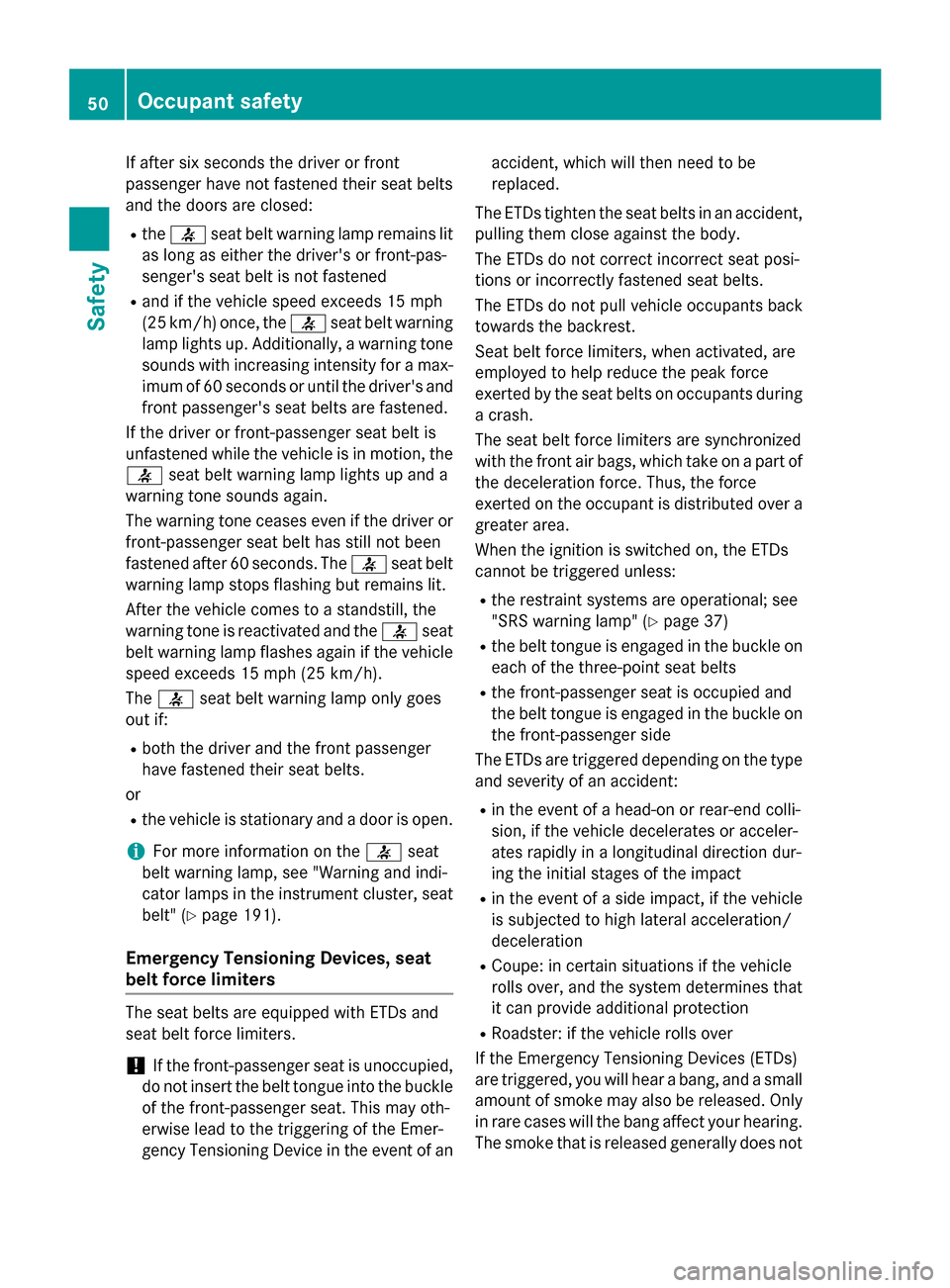
If after six seconds the driver or front
passenger have not fastened their seat belts
and the doors are closed:
R the 0076 seat belt warning lamp remains lit
as long as either the driver's or front-pas-
senger's seat belt is not fastened
R and if the vehicle speed exceeds 15 mph
(25 km/h )once, the 0076seat belt warning
lamp lights up. Additionally, awarning tone
sounds with increasing intensity for amax-
imum of 60 seconds or until the driver's and
front passenger's seat belts are fastened.
If the driver or front-passenger seat belt is
unfastened whilet he vehicle is in motion, the
0076 seat belt warning lamp lights up and a
warning tone sounds again.
The warning tone ceases even if the driver or
front-passenger seat belt has still not been
fastened after 60 seconds. The 0076seat belt
warning lamp stops flashing but remains lit.
After the vehicle comes to astandstill ,the
warning tone is reactivated and the 0076seat
belt warning lamp flashes again if the vehicle
speed exceeds 15 mph (25 km/h).
The 0076 seat belt warning lamp only goes
out if:
R both the driver and the front passenger
have fastened their seat belts.
or
R the vehicle is stationary and adoor is open.
i For more information on the
0076seat
belt warning lamp,s ee "Warning and indi-
cator lampsint he instrument cluster, seat
belt" (Y page 191).
Emergency Tensioning Devices, seat
beltf orce limiters The seat belts are equippedw
ith ETDs and
seat belt force limiters.
! If the front-passenger seat is unoccupied,
do not insert the belt tongue into the buckle of the front-passenger seat. This may oth-
erwisel eadtot he triggering of the Emer-
gency Tensioning Device in the event of an accident, which willt
hen need to be
replaced.
The ETDs tighten the seat belts in an accident,
pulling them close against the body.
The ETDs do not correct incorrect seat posi-
tions or incorrectly fastened seat belts.
The ETDs do not pullv ehicle occupants back
towards the backrest.
Seat belt force limiters, when activated, are
employed to help reduce the peak force
exerted by the seat belts on occupants during ac rash.
The seat belt force limiters are synchronized
with the front air bags,w hich take onapart of
the deceleration force. Thus, the force
exerted on the occupant is distributed over a
greater area.
When the ignition is switched on, the ETDs
cannot be triggered unless:
R the restraint systems are operational; see
"SRS warning lamp"( Ypage 37)
R the belt tongue is engage dinthe buckle on
each of the three-point seat belts
R the front-passenger seat is occupie dand
the belt tongue is engage dinthe buckle on
the front-passenger side
The ETDs are triggered depending on the type
and severity of an accident:
R in the event of ahead-on or rear-end colli-
sion, if the vehicle decelerates or acceler-
ates rapidly in alongitudinal direction dur-
ing the initial stages of the impact
R in the event of aside impact, if the vehicle
is subjected to high latera lacceleration/
deceleration
R Coupe: in certain situations if the vehicle
rolls over, and the system determines that
it can provide additional protection
R Roadster: if the vehicle rolls over
If the Emergency Tensioning Devices (ETDs)
are triggered, you willh earabang, and asmall
amount of smoke may also be released. Only
in rare cases willt he bang affect yourh earing.
The smoke that is released generally does not 50
Occupant safetySafety
Page 57 of 290
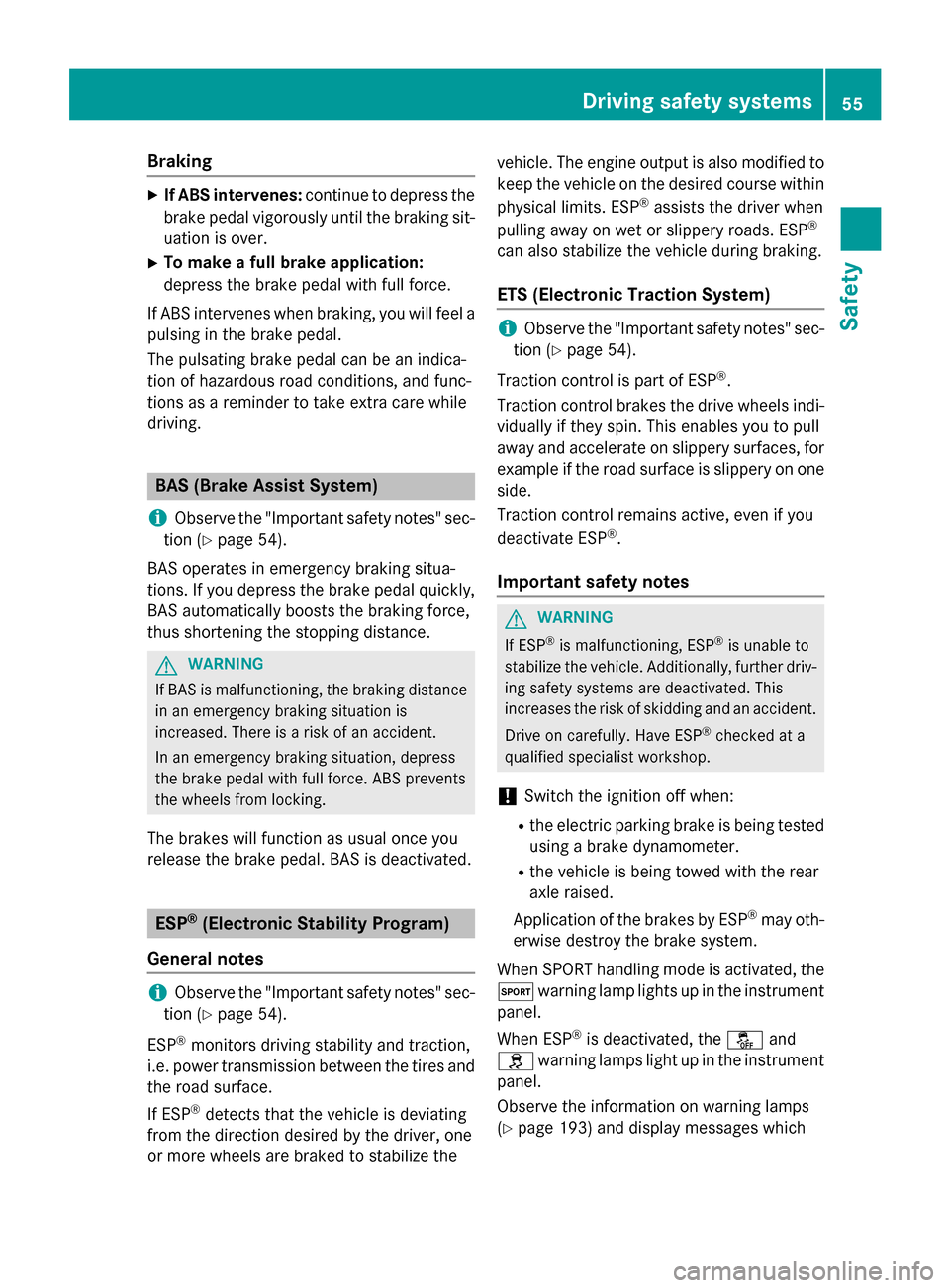
Braking
X
If ABS intervenes: continue to depress the
brake peda lvigorously unti lthe braking sit-
uatio niso ver.
X To make afullb rake application:
depress the brake peda lwithf ullf orce.
If ABS intervenes when braking ,you will fee la
pulsing in the brake pedal.
The pulsating brake peda lcan be an indica-
tio nofh azardou sroadc onditions, and func-
tions as areminder to take extra car ewhile
driving. BAS (Brak
eAssis tSystem)
i Observ
ethe "Important safety notes "sec-
tio n(Ypage 54).
BAS operates in emergency braking situa-
tions. If yo udepress the brake peda lquickly,
BAS automaticall yboosts the braking force,
thu sshortening the stopping distance. G
WARNING
If BAS is malfunctioning ,the braking distance
in an emergency braking situatio nis
increased .There is ariskofana ccident.
In an emergency braking situation, depress
the brake peda lwithf ullf orce. ABS prevents
the wheels from locking.
The brakes will functio nasusual once you
release the brake pedal. BAS is deactivated. ESP
®
(Electroni cStability Program)
General notes i
Observ
ethe "Important safety notes "sec-
tio n(Ypage 54).
ESP ®
monitors driving stability and traction,
i.e .power transmission between the tire sand
the roa dsurface.
If ESP ®
detects tha tthe vehicl eisdeviating
from the direction desired by the driver ,one
or more wheels ar ebraked to stabilize the vehicle. The engine outpu
tisa lsom odified to
kee pthe vehicl eonthe desired course within
physical limits .ESP ®
assists the driver when
pulling away on we torslipper yroads. ESP ®
can also stabilize the vehicl eduring braking.
ETS (Electroni cTraction System) i
Observ
ethe "Important safety notes "sec-
tio n(Ypage 54).
Tractio ncontro lispartofE SP®
.
Tractio ncontro lbrakes the drive wheels indi-
viduall yifthey spin. Thi senables yo utopull
away and accelerate on slippery surfaces, for
exampl eifthe roa dsurface is slippery on one
side.
Tractio ncontro lremains active, eve nifyou
deactivate ESP ®
.
Important safety notes G
WARNING
If ESP ®
is malfunctioning ,ESP ®
is unabl eto
stabilize the vehicle. Additionally, further driv- ing safety system sare deactivated. This
increases the ris kofskidding and an accident.
Driv eonc arefully. Hav eESP®
checked at a
qualified specialist workshop.
! Switch the ignition off when:
R the electri cparking brake is being tested
using abrake dynamometer.
R the vehicl eisbeing towed with the rear
axl eraised.
Application of the brakes by ESP ®
ma yoth-
erwis edestro ythe brake system.
Whe nSPOR Thandling mod eisactivated ,the
0074 warning lamp lights up in the instrument
panel.
Whe nESP®
is deactivated ,the 00BB and
0089 warning lamps light up in the instrument
panel.
Observ ethe informatio nonwarning lamps
(Y page 193 )and display messages which Driving safety systems
55Safety Z
Page 61 of 290
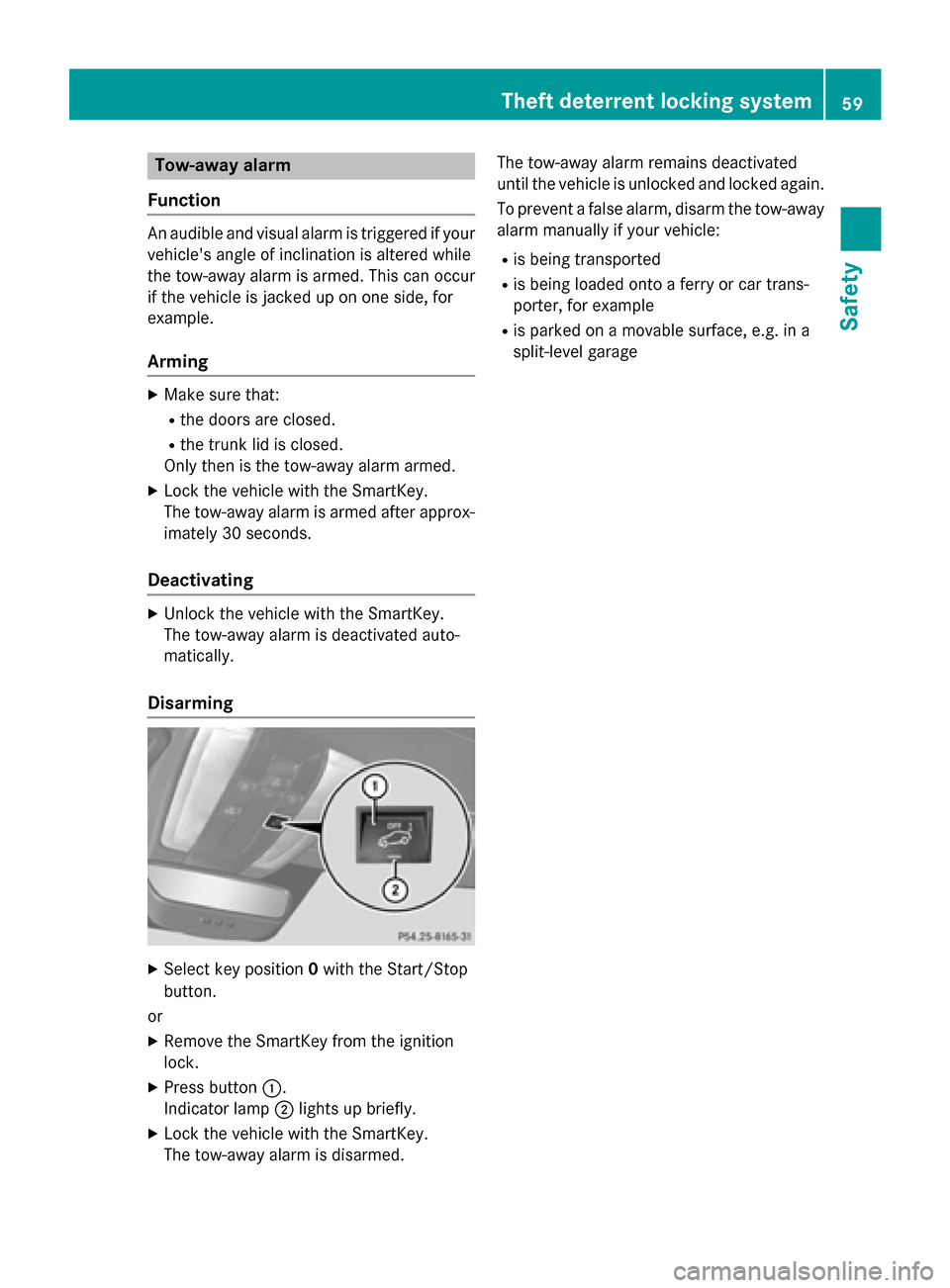
Tow-away alarm
Function An audibl
eand visua lalarm is triggered if your
vehicle's angle of inclinatio nisa ltere dw hile
the tow-away alar misarmed.Thisc an occur
if the vehicl eisjacke dupono ne side,for
example.
Arming X
Make sure that:
R the doors ar eclosed.
R the trunk li disclosed.
Onl ythen is the tow-away alar marmed.
X Lock the vehicl ewitht he SmartKey.
The tow-away alar misarmed after approx-
imatel y30seconds.
Deactivating X
Unlock the vehicl ewitht he SmartKey.
The tow-away alar misdeactivated auto-
matically.
Disarming X
Select key position 0with the Start/Stop
button.
or X Remov ethe SmartKe yfromt he ignition
lock.
X Press button 0043.
Indicato rlamp 0044lights up briefly.
X Lock the vehicl ewitht he SmartKey.
The tow-away alar misdisarmed. The tow-away alar
mremains deactivated
unti lthe vehicl eisunlocke dand locked again.
To prevent afalse alarm, disarm the tow-away
alar mm anuall yify ourv ehicle:
R is being transported
R is being loaded onto aferry or car trans-
porter ,for example
R is parked on amovable surface, e.g .ina
split-level garage Thef
tdeterren tlocking system
59Safety Z
Page 64 of 290

Useful information
i This Operator's Manual describes all
models and all standard and optional equip- ment of your vehicle available at the time of
publication of the Operator's Manual.
Country-specific differences are possible.
Please not ethat your vehicle may not be
equipped with all feature sdescribed. This
also applies to safety-related system sand
functions.
i Please read the information on qualified
specialist workshops (Y page 23).SmartKey
Key function
Genera lnotes i
USA only:
This device complies with Part 15 of the
FCC Rules. Operation is subjec ttothe fol-
lowing two conditions:
1. This device may not cause harmful inter-
ference, and
2. this device must accept any interference received, including interferenc ethat may
cause undesired operation of the device.
Anyu nauthorized modification to this
device could void the user's authorit yto
operate the equipment.
The Product label with FCC ID and IC cer-
tification number can be found in the bat-
ter yc ase of the SmartKey.
i Canada only:
This device complies with RSS-210 of
Industry Canada. Operation is subjec tto
the following two conditions:
1. This device may not cause harmful inter- ference, and
2. this device must accept any interference
received, including interferenc ethat may
cause undesired operation of the device. Anyu
nauthorized modification to this
device could void the user's authorit yto
operate the equipment.
The Product label with FCC ID and IC cer-
tification number can be found in the bat-
ter yc ase of the SmartKey.
Locking/unlocking centrally The SmartKey centrally locks/unlocks:
R the doors
R the trun klid
R the fuel filler flap
R Roadster only: the glove box
R Roadster only: the stowage compartment
under the armrest G
WARNING
If children are left unsupervised in the vehicle, they could:
R open the doors, thus endangering other
people or road users.
R get out and disrupt traffic.
R operate the vehicle' sequipment.
Additionally, children could set the vehicle in
motion if, for example, they:
R release the parkin gbrake.
R shifting the automatic transmission out of
park position P
R Start the engine.
There is arisk of an acciden tand injury.
When leaving the vehicle, always tak ethe
SmartKey with you and lock the vehicle. Never
leave children or animals unattended in the
vehicle. Always keep the SmartKey out of
reach of children. 62
SmartKeyOpening and closing
Page 70 of 290
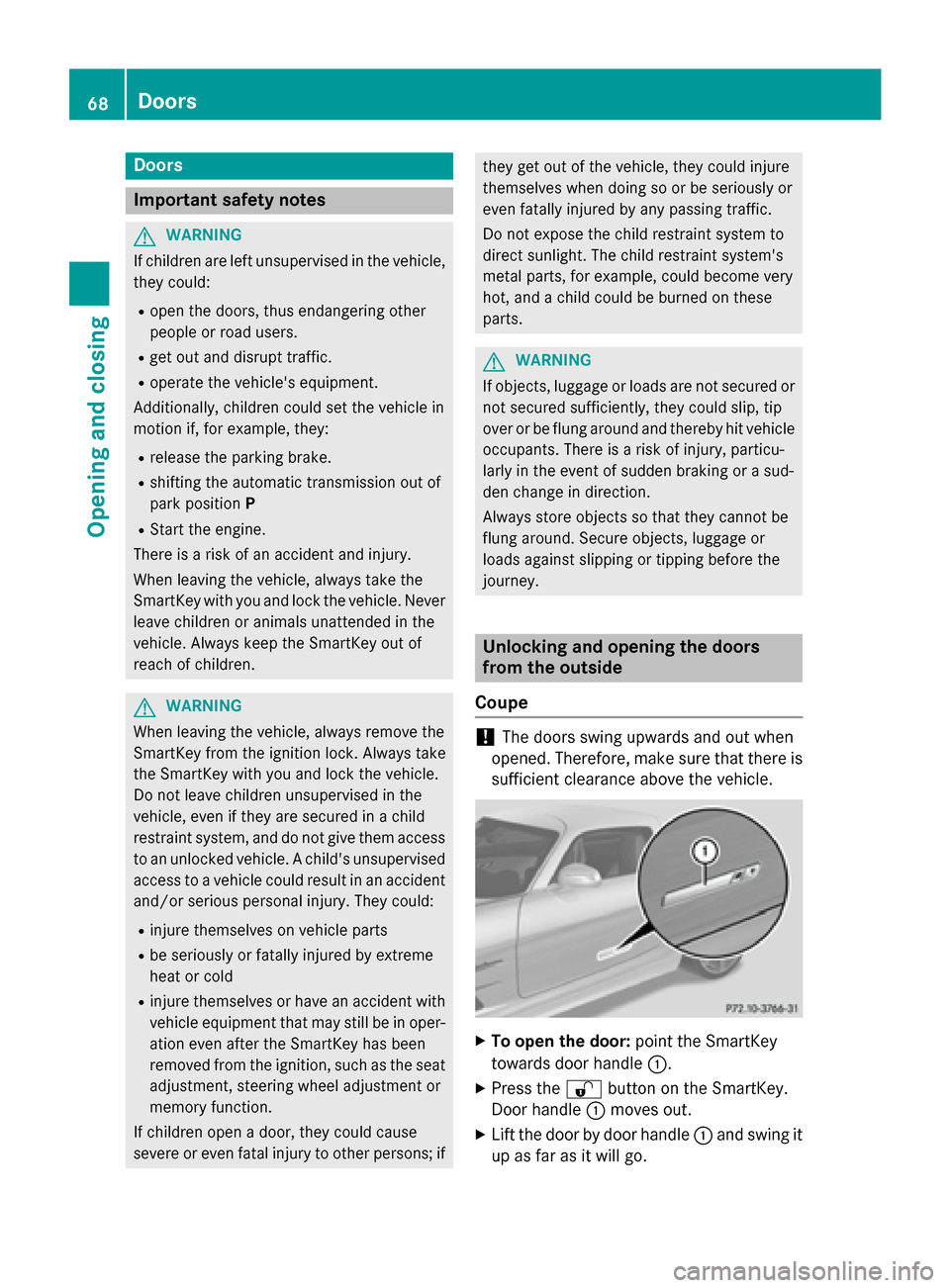
Doors
Important safet
ynotes G
WARNING
If children are lef tunsupervised in th evehicle,
they could:
R ope nthe doors ,thu se ndangerin gother
people or road users.
R get out and disrup ttraffic.
R operat ethe vehicle' sequipment.
Additionally, children could set th evehicle in
motion if, fo rexample, they:
R release th eparking brake.
R shiftin gthe automatic transmissio nout of
par kposition P
R Start th eengine.
There is ariskofana ccidentand injury.
Whe nleavin gthe vehicle, always take the
SmartKey wit hyou and loc kthe vehicle. Never
leav echildren or animals unattended in the
vehicle. Always keep th eSmartKey out of
reach of children. G
WARNING
Whe nleavin gthe vehicle, always remov ethe
SmartKey from th eignition lock. Always take
th eS martKey wit hyou and loc kthe vehicle.
Do no tleav echildren unsupervised in the
vehicle, eve niftheya re secure dinachild
restrain tsystem, and do no tgivet he ma ccess
to an unlocke dvehicle. Achild' su nsupervised
access to avehicle could result in an accident
and/o rserious personal injury. The ycould:
R injure themselves on vehicle parts
R be seriously or fatally injured by extreme
heat or cold
R injure themselves or hav eanacciden twith
vehicle equipmen ttha tm ay still be in oper-
ation eve nafter th eSmartKey has been
removed from th eignition ,suc hast heseat
adjustment, steerin gwhee ladjustmen tor
memor yfunction.
If children ope nadoor, they could cause
severe or eve nfatal injury to other persons; if they get out of th
evehicle, they could injure
themselves when doin gsoorbeseriously or
eve nfatally injured by any passin gtraffic.
Do no texposet he child restrain tsystem to
direc tsunlight. The child restrain tsystem's
metal parts ,for example, could becom every
hot ,and achild could be burne donthese
parts. G
WARNING
If objects ,luggage or load sare no tsecure dor
no tsecure dsufficiently, they could slip ,tip
over or be flun garound and thereby hit vehicle
occupants. There is ariskofi njury, particu-
larl yint he event of sudden braking or asud-
den chang eindirection.
Always stor eobjects so that they canno tbe
flun garound .Secureo bjects ,luggage or
load sagainst slippin gortippin gb efor ethe
journey. Unlockin
gand opening th edoors
from th eoutside
Coupe !
The doors swin
gupwards and out when
opened. Therefore, mak esuret hatthe re is
sufficien tclearanc eabov ethe vehicle. X
To ope nthe door: pointthe SmartKey
toward sdoorh andle 0043.
X Press the 0036buttonont heSmartKey.
Door handle 0043moves out.
X Lif tthe doo rbyd oorh andle 0043and swin git
up as far as it will go. 68
DoorsOpening an
dclosing
Page 71 of 290
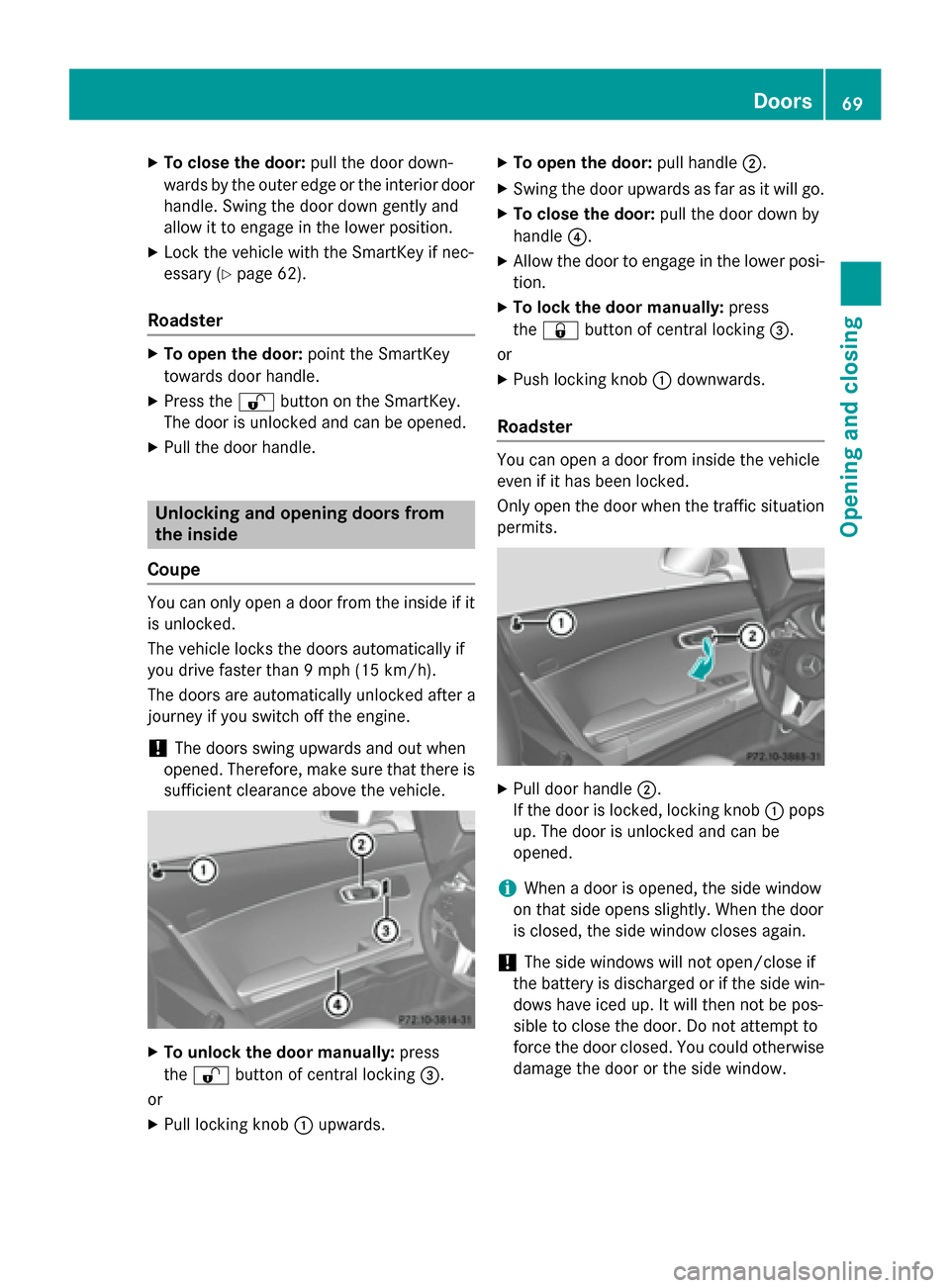
X
To clos ethe door: pull the door down-
wards by the outer edge or the interio rdoor
handle. Swing the door down gently and
allo wittoe ngageint he lowe rposit ion.
X Lock the vehicl ewitht he SmartKe yifnec-
essar y(Ypage 62).
Roadster X
To ope nthe door: point the SmartKey
towards door handle.
X Press the 0036button on the SmartKey.
The door is unlocke dand can be opened.
X Pull the door handle. Unlockin
gand opening doors from
the inside
Coupe Yo
uc an onl yopenad oorfrom the insid eifit
is unlocked.
The vehicl eloc ks the doors automaticall yif
yo ud rive faster tha n9mph (15 km/h).
The doors ar eautomaticall yunlocke dafter a
journey if yo uswitch off the engine.
! The doors swing upwards and ou
twhen
opened. Therefore ,makes uret hatther eis
sufficient clearance above the vehicle. X
To unloc kthe doo rmanually: press
the 0036 button of centra lloc king 0087.
or X Pull locking knob 0043upwards. X
To ope nthe door: pull handle 0044.
X Swing the door upwards as fa rasitwillg o.
X To clos ethe door: pull the door down by
handle 0085.
X Allow the door to engag einthe lowe rposi-
tion.
X To lock the doo rmanually: press
the 0037 button of centra lloc king 0087.
or X Push locking knob 0043downwards.
Roadster Yo
uc an open adoorfrom insid ethe vehicle
eve nifith asbeen locked.
Onl yopent he door when the traffic situation
permits. X
Pull door handle 0044.
If the door is locked ,loc king knob 0043pops
up .The door is unlocke dand can be
opened.
i Whe
nad ooriso pened, the side window
on tha tsideo pens slightly. Whe nthe door
is closed ,the side windo wcloses again.
! The side windows will not open/close if
the battery is discharge dorifthe side win-
dows have ice dup.It will then not be pos-
sibl etoc lose the door. Do not attempt to
forc ethe door closed .You could otherwise
damage the door or the side window. Doors
69Opening and closing Z